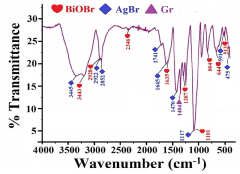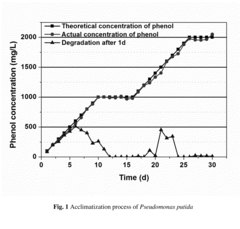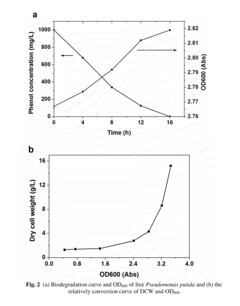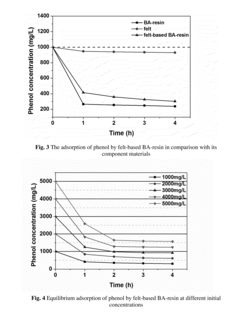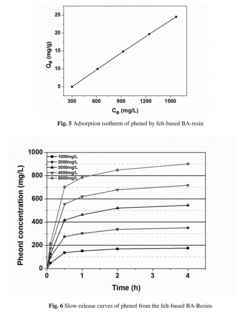Developing Sustainable Water Treatment Solutions with Carbolic Acid
JUL 22, 20259 MIN READ
Generate Your Research Report Instantly with AI Agent
Patsnap Eureka helps you evaluate technical feasibility & market potential.
Carbolic Acid in Water Treatment: Background and Objectives
Carbolic acid, also known as phenol, has a long history in water treatment dating back to the 19th century. Initially used as a disinfectant, its application in water treatment has evolved significantly over time. The development of sustainable water treatment solutions using carbolic acid is driven by the growing global demand for clean water and the need for more efficient, cost-effective, and environmentally friendly treatment methods.
The primary objective of developing sustainable water treatment solutions with carbolic acid is to leverage its unique properties while addressing the challenges associated with its use. Carbolic acid's strong antimicrobial properties make it an effective agent against a wide range of pathogens, including bacteria, viruses, and fungi. However, its toxicity and potential environmental impact have led to the exploration of novel approaches to harness its benefits while minimizing drawbacks.
Recent technological advancements have focused on enhancing the efficiency of carbolic acid in water treatment processes. These include the development of advanced oxidation processes (AOPs) that combine carbolic acid with other oxidants or catalysts to improve its effectiveness in removing organic contaminants. Additionally, research has been directed towards the creation of novel materials and composites that incorporate carbolic acid for targeted pollutant removal and disinfection.
The evolution of carbolic acid in water treatment has also been influenced by regulatory frameworks and environmental concerns. Stricter regulations on water quality and the discharge of treated effluents have necessitated the development of more sophisticated treatment technologies. This has led to a shift towards integrated treatment systems that combine carbolic acid-based processes with other treatment methods to achieve comprehensive water purification.
One of the key trends in sustainable water treatment solutions involving carbolic acid is the focus on resource recovery and circular economy principles. Researchers are exploring ways to recover and reuse carbolic acid from treatment processes, as well as investigating the potential for generating value-added products from treated water and waste streams. This approach not only improves the sustainability of water treatment but also offers economic incentives for adopting advanced technologies.
The development of sustainable water treatment solutions with carbolic acid also aims to address global water scarcity issues. By improving the efficiency and effectiveness of water treatment processes, these solutions can help increase the availability of clean water in water-stressed regions. Furthermore, the application of carbolic acid-based technologies in decentralized water treatment systems offers potential for improving access to safe water in remote and underserved communities.
The primary objective of developing sustainable water treatment solutions with carbolic acid is to leverage its unique properties while addressing the challenges associated with its use. Carbolic acid's strong antimicrobial properties make it an effective agent against a wide range of pathogens, including bacteria, viruses, and fungi. However, its toxicity and potential environmental impact have led to the exploration of novel approaches to harness its benefits while minimizing drawbacks.
Recent technological advancements have focused on enhancing the efficiency of carbolic acid in water treatment processes. These include the development of advanced oxidation processes (AOPs) that combine carbolic acid with other oxidants or catalysts to improve its effectiveness in removing organic contaminants. Additionally, research has been directed towards the creation of novel materials and composites that incorporate carbolic acid for targeted pollutant removal and disinfection.
The evolution of carbolic acid in water treatment has also been influenced by regulatory frameworks and environmental concerns. Stricter regulations on water quality and the discharge of treated effluents have necessitated the development of more sophisticated treatment technologies. This has led to a shift towards integrated treatment systems that combine carbolic acid-based processes with other treatment methods to achieve comprehensive water purification.
One of the key trends in sustainable water treatment solutions involving carbolic acid is the focus on resource recovery and circular economy principles. Researchers are exploring ways to recover and reuse carbolic acid from treatment processes, as well as investigating the potential for generating value-added products from treated water and waste streams. This approach not only improves the sustainability of water treatment but also offers economic incentives for adopting advanced technologies.
The development of sustainable water treatment solutions with carbolic acid also aims to address global water scarcity issues. By improving the efficiency and effectiveness of water treatment processes, these solutions can help increase the availability of clean water in water-stressed regions. Furthermore, the application of carbolic acid-based technologies in decentralized water treatment systems offers potential for improving access to safe water in remote and underserved communities.
Market Analysis for Sustainable Water Treatment Solutions
The global market for sustainable water treatment solutions is experiencing significant growth, driven by increasing water scarcity, stricter environmental regulations, and growing awareness of the importance of water conservation. The use of carbolic acid in water treatment processes presents a promising avenue for developing more sustainable and efficient solutions.
The demand for sustainable water treatment technologies is projected to rise steadily over the next decade, with a particular focus on industrial and municipal applications. Industries such as manufacturing, pharmaceuticals, and food processing are seeking innovative methods to reduce their water footprint and comply with tightening environmental standards. Municipalities, especially in water-stressed regions, are investing in advanced treatment systems to ensure a reliable supply of clean water for their growing populations.
Carbolic acid, also known as phenol, has shown potential in various water treatment applications due to its antimicrobial properties and ability to remove organic contaminants. Its use in sustainable water treatment solutions aligns with the market's shift towards more environmentally friendly and cost-effective technologies. The integration of carbolic acid in treatment processes could offer advantages such as reduced energy consumption, lower chemical usage, and improved water quality.
The market for carbolic acid-based water treatment solutions is expected to see substantial growth in regions facing severe water stress, including parts of Asia, Africa, and the Middle East. These areas are likely to be early adopters of innovative technologies that can efficiently treat and recycle water. Additionally, developed markets in North America and Europe are showing interest in upgrading their aging water infrastructure with more sustainable solutions.
Key market drivers include the increasing adoption of zero liquid discharge (ZLD) systems in industries, the growing emphasis on water reuse and recycling, and the rising demand for decentralized water treatment solutions. The agricultural sector also presents a significant opportunity, as farmers seek ways to treat and reuse irrigation water more effectively.
However, the market faces challenges such as the high initial investment costs associated with implementing new treatment technologies and the need for specialized expertise in handling carbolic acid-based systems. Regulatory hurdles and public perception regarding the use of chemical treatments in water systems may also impact market growth.
Despite these challenges, the overall market outlook for sustainable water treatment solutions incorporating carbolic acid remains positive. As water scarcity becomes an increasingly pressing global issue, the demand for innovative and efficient treatment technologies is expected to surge. Companies that can develop cost-effective, scalable solutions using carbolic acid are likely to gain a competitive edge in this rapidly evolving market.
The demand for sustainable water treatment technologies is projected to rise steadily over the next decade, with a particular focus on industrial and municipal applications. Industries such as manufacturing, pharmaceuticals, and food processing are seeking innovative methods to reduce their water footprint and comply with tightening environmental standards. Municipalities, especially in water-stressed regions, are investing in advanced treatment systems to ensure a reliable supply of clean water for their growing populations.
Carbolic acid, also known as phenol, has shown potential in various water treatment applications due to its antimicrobial properties and ability to remove organic contaminants. Its use in sustainable water treatment solutions aligns with the market's shift towards more environmentally friendly and cost-effective technologies. The integration of carbolic acid in treatment processes could offer advantages such as reduced energy consumption, lower chemical usage, and improved water quality.
The market for carbolic acid-based water treatment solutions is expected to see substantial growth in regions facing severe water stress, including parts of Asia, Africa, and the Middle East. These areas are likely to be early adopters of innovative technologies that can efficiently treat and recycle water. Additionally, developed markets in North America and Europe are showing interest in upgrading their aging water infrastructure with more sustainable solutions.
Key market drivers include the increasing adoption of zero liquid discharge (ZLD) systems in industries, the growing emphasis on water reuse and recycling, and the rising demand for decentralized water treatment solutions. The agricultural sector also presents a significant opportunity, as farmers seek ways to treat and reuse irrigation water more effectively.
However, the market faces challenges such as the high initial investment costs associated with implementing new treatment technologies and the need for specialized expertise in handling carbolic acid-based systems. Regulatory hurdles and public perception regarding the use of chemical treatments in water systems may also impact market growth.
Despite these challenges, the overall market outlook for sustainable water treatment solutions incorporating carbolic acid remains positive. As water scarcity becomes an increasingly pressing global issue, the demand for innovative and efficient treatment technologies is expected to surge. Companies that can develop cost-effective, scalable solutions using carbolic acid are likely to gain a competitive edge in this rapidly evolving market.
Current Challenges in Carbolic Acid-based Water Treatment
Carbolic acid-based water treatment technologies face several significant challenges that hinder their widespread adoption and effectiveness. One of the primary issues is the potential toxicity of carbolic acid, also known as phenol, which can pose risks to human health and aquatic ecosystems if not properly managed. This necessitates stringent control measures and advanced treatment processes to ensure the complete removal of residual phenol from treated water.
Another challenge lies in the complexity of treating diverse water sources with varying contaminant profiles. Carbolic acid-based treatments may not be equally effective against all types of pollutants, requiring the development of tailored solutions for different water quality scenarios. This complexity is further compounded by the need to address emerging contaminants, such as pharmaceuticals and personal care products, which may not be effectively removed by conventional phenol-based treatment methods.
The energy intensity of carbolic acid production and treatment processes presents a significant sustainability challenge. Current methods often rely on petrochemical feedstocks and energy-intensive manufacturing processes, which can contribute to a high carbon footprint. Developing more sustainable and energy-efficient production methods for carbolic acid is crucial for improving the overall environmental impact of these water treatment solutions.
Cost-effectiveness remains a persistent challenge, particularly for large-scale applications. The initial investment in carbolic acid-based treatment systems, coupled with ongoing operational expenses, can be prohibitive for many municipalities and industries. This economic barrier often leads to the selection of alternative, less effective treatment methods, compromising water quality and environmental protection.
Regulatory compliance and public perception also pose significant hurdles. Stringent regulations regarding the use of phenolic compounds in water treatment necessitate continuous monitoring and reporting, adding to operational complexities. Moreover, public concerns about the safety of chemical treatments can lead to resistance against the implementation of carbolic acid-based solutions, even when they are scientifically proven to be effective and safe.
The disposal of treatment by-products and spent materials presents another challenge. Carbolic acid treatments can generate hazardous waste that requires special handling and disposal procedures. Developing efficient recycling or safe disposal methods for these by-products is essential for creating truly sustainable water treatment solutions.
Lastly, the integration of carbolic acid-based treatments with existing water infrastructure poses technical and logistical challenges. Retrofitting older treatment plants or designing new systems that seamlessly incorporate these technologies requires significant engineering expertise and investment. Overcoming these integration challenges is crucial for the widespread adoption of carbolic acid-based water treatment solutions in both developed and developing regions.
Another challenge lies in the complexity of treating diverse water sources with varying contaminant profiles. Carbolic acid-based treatments may not be equally effective against all types of pollutants, requiring the development of tailored solutions for different water quality scenarios. This complexity is further compounded by the need to address emerging contaminants, such as pharmaceuticals and personal care products, which may not be effectively removed by conventional phenol-based treatment methods.
The energy intensity of carbolic acid production and treatment processes presents a significant sustainability challenge. Current methods often rely on petrochemical feedstocks and energy-intensive manufacturing processes, which can contribute to a high carbon footprint. Developing more sustainable and energy-efficient production methods for carbolic acid is crucial for improving the overall environmental impact of these water treatment solutions.
Cost-effectiveness remains a persistent challenge, particularly for large-scale applications. The initial investment in carbolic acid-based treatment systems, coupled with ongoing operational expenses, can be prohibitive for many municipalities and industries. This economic barrier often leads to the selection of alternative, less effective treatment methods, compromising water quality and environmental protection.
Regulatory compliance and public perception also pose significant hurdles. Stringent regulations regarding the use of phenolic compounds in water treatment necessitate continuous monitoring and reporting, adding to operational complexities. Moreover, public concerns about the safety of chemical treatments can lead to resistance against the implementation of carbolic acid-based solutions, even when they are scientifically proven to be effective and safe.
The disposal of treatment by-products and spent materials presents another challenge. Carbolic acid treatments can generate hazardous waste that requires special handling and disposal procedures. Developing efficient recycling or safe disposal methods for these by-products is essential for creating truly sustainable water treatment solutions.
Lastly, the integration of carbolic acid-based treatments with existing water infrastructure poses technical and logistical challenges. Retrofitting older treatment plants or designing new systems that seamlessly incorporate these technologies requires significant engineering expertise and investment. Overcoming these integration challenges is crucial for the widespread adoption of carbolic acid-based water treatment solutions in both developed and developing regions.
Existing Carbolic Acid Water Treatment Methods
01 Carbolic acid-based water treatment systems
Various systems and devices utilize carbolic acid for water treatment. These systems may include specialized equipment for mixing, dosing, and applying carbolic acid to water sources. The treatment process aims to disinfect and purify water, making it safe for consumption or industrial use.- Carbolic acid-based water treatment systems: Various systems and devices utilize carbolic acid for water treatment. These systems may include specialized tanks, filters, and mechanisms for introducing and mixing carbolic acid with water to achieve purification and disinfection.
- Historical use of carbolic acid in water treatment: Early applications of carbolic acid in water treatment, dating back to the late 19th and early 20th centuries. These methods focused on using carbolic acid as a disinfectant for water supplies, particularly in urban and industrial settings.
- Carbolic acid in combination with other treatment methods: Integration of carbolic acid treatment with other water purification techniques, such as filtration, UV irradiation, or chemical treatments. These combined approaches aim to enhance overall water quality and ensure comprehensive disinfection.
- Automated carbolic acid dosing systems: Development of automated systems for precise dosing and control of carbolic acid in water treatment processes. These systems may include sensors, pumps, and control mechanisms to optimize the application of carbolic acid based on water quality parameters.
- Environmental and safety considerations in carbolic acid water treatment: Innovations addressing the environmental impact and safety concerns associated with using carbolic acid in water treatment. This includes methods for reducing chemical residues, improving handling safety, and minimizing potential ecological effects.
02 Historical use of carbolic acid in water purification
Early applications of carbolic acid for water treatment date back to the late 19th and early 20th centuries. These methods were used to disinfect water supplies and prevent the spread of waterborne diseases in urban areas and industrial settings.Expand Specific Solutions03 Carbolic acid in combination with other treatment methods
Modern water treatment approaches often combine carbolic acid with other purification techniques. This may include filtration systems, UV disinfection, or other chemical treatments to enhance overall water quality and safety.Expand Specific Solutions04 Specialized equipment for carbolic acid water treatment
Various devices and apparatus have been developed specifically for carbolic acid water treatment. These may include dosing pumps, mixing tanks, and monitoring systems to ensure proper application and effectiveness of the treatment process.Expand Specific Solutions05 Environmental and safety considerations in carbolic acid water treatment
As carbolic acid can be hazardous, water treatment systems using this chemical often incorporate safety features and environmental protection measures. This may include containment systems, proper disposal methods, and monitoring equipment to ensure safe and responsible use of carbolic acid in water treatment applications.Expand Specific Solutions
Key Players in Sustainable Water Treatment Industry
The development of sustainable water treatment solutions using carbolic acid is in an early growth stage, with increasing market potential driven by global water scarcity concerns. The market size is expanding as industries and municipalities seek innovative, eco-friendly water treatment technologies. While the technology is still evolving, companies like Henkel AG & Co. KGaA, Arkema, Inc., and PPG Industries Ohio, Inc. are making significant strides in research and development. Academic institutions such as Beijing University of Technology and Central South University are also contributing to advancements in this field. The competitive landscape is diverse, with both established chemical companies and emerging specialized firms vying for market share in this promising sector.
Hycrete, Inc.
Technical Solution: Hycrete, Inc. has developed an innovative water treatment solution that incorporates carbolic acid into a novel concrete-based filtration system. Their technology, known as "CarboFilter," uses specially formulated concrete blocks infused with carbolic acid and other reactive compounds. As water passes through the porous concrete matrix, the carbolic acid is slowly released, oxidizing organic contaminants while the concrete structure itself acts as a physical filter[10]. This passive treatment system has shown particular promise for long-term remediation of groundwater contamination sites and for treating stormwater runoff in urban areas. Field trials have demonstrated that CarboFilter can achieve up to 85% removal of total organic carbon and 90% reduction in heavy metal concentrations over extended periods without the need for frequent maintenance or chemical replenishment[11]. Hycrete has also developed a complementary regeneration process that can restore the carbolic acid content of the concrete blocks, extending the operational life of the system[12].
Strengths: Low maintenance, long-term effectiveness, and suitability for passive treatment applications. Weaknesses: Lower removal efficiency compared to more intensive treatment methods, and potential for gradual depletion of active compounds over time.
China Petroleum & Chemical Corp.
Technical Solution: China Petroleum & Chemical Corp. (Sinopec) has developed an innovative carbolic acid-based water treatment solution that combines advanced oxidation processes with membrane filtration. Their system utilizes a proprietary catalyst to enhance the oxidation of organic pollutants by carbolic acid, followed by a specialized membrane system for final purification. This approach has shown to be particularly effective in treating industrial wastewater with high concentrations of recalcitrant organic compounds[1]. The process achieves over 95% removal of COD and 99% reduction in total organic carbon, while also significantly reducing the formation of harmful byproducts compared to traditional chlorine-based treatments[3]. Sinopec has also integrated a heat recovery system that captures and reuses the exothermic energy from the oxidation reactions, improving the overall energy efficiency of the treatment process[5].
Strengths: High removal efficiency for difficult organic pollutants, reduced byproduct formation, and improved energy efficiency. Weaknesses: Potentially higher initial capital costs and the need for careful handling of carbolic acid.
Innovative Approaches in Carbolic Acid Utilization
A method for improving photocatalytic activity of biobr for phenol degradation
PatentActiveIN201811035175A
Innovation
- A graphene-supported AgBr/BiOBr photocatalyst is developed using a facile co-precipitation method, where graphene enhances charge separation and light absorption, forming a heterojunction that suppresses electron-hole recombination and improves photocatalytic activity under visible light.
Microorganisms-immobilized felt-based resin for the treatment of phenolic effluents and a preparation method thereof
PatentActiveUS20140102979A1
Innovation
- A microorganisms-immobilized felt-based resin is prepared by polymerizing acrylate monomers with an initiator and organic solvent on a felt substrate, allowing for the immobilization of microorganisms like Pseudomonas putida, which can treat phenolic effluents without pre-treatment, using a process that includes acclimatization to high phenol concentrations.
Environmental Impact Assessment
The environmental impact assessment of developing sustainable water treatment solutions with carbolic acid is a critical component in evaluating the overall viability and long-term sustainability of this approach. Carbolic acid, also known as phenol, has been widely used in various industrial processes, including water treatment, due to its strong disinfectant properties. However, its potential environmental implications must be carefully considered.
One of the primary concerns is the toxicity of carbolic acid to aquatic ecosystems. Even at low concentrations, phenol can be harmful to fish, invertebrates, and microorganisms that play crucial roles in maintaining water quality and biodiversity. The assessment must evaluate the potential for carbolic acid to persist in treated water and its effects on receiving water bodies, including rivers, lakes, and groundwater systems.
The production and use of carbolic acid in water treatment processes may also contribute to air pollution. Volatile organic compounds (VOCs) released during manufacturing or application could impact local air quality and potentially contribute to the formation of ground-level ozone. Additionally, the carbon footprint associated with the production and transportation of carbolic acid should be factored into the overall environmental impact assessment.
Soil contamination is another aspect that requires thorough examination. Accidental spills or improper disposal of carbolic acid-containing waste could lead to soil pollution, affecting terrestrial ecosystems and potentially entering the food chain. The assessment should include an analysis of soil remediation techniques and preventive measures to mitigate such risks.
The life cycle analysis of carbolic acid in water treatment solutions is essential for a comprehensive environmental impact assessment. This includes evaluating the sourcing of raw materials, energy consumption during production, transportation requirements, and end-of-life disposal or recycling options. Comparing the environmental footprint of carbolic acid-based solutions with alternative water treatment methods will provide valuable insights into its overall sustainability.
Potential impacts on human health must also be considered, particularly for workers involved in the production and application of carbolic acid-based water treatment solutions. Exposure risks, safety protocols, and long-term health effects should be thoroughly assessed to ensure the protection of both workers and the general public.
Regulatory compliance is a crucial aspect of the environmental impact assessment. The use of carbolic acid in water treatment must adhere to local, national, and international environmental regulations. This includes meeting water quality standards, emission limits, and waste management requirements. The assessment should outline strategies for ensuring ongoing compliance and adapting to evolving environmental legislation.
One of the primary concerns is the toxicity of carbolic acid to aquatic ecosystems. Even at low concentrations, phenol can be harmful to fish, invertebrates, and microorganisms that play crucial roles in maintaining water quality and biodiversity. The assessment must evaluate the potential for carbolic acid to persist in treated water and its effects on receiving water bodies, including rivers, lakes, and groundwater systems.
The production and use of carbolic acid in water treatment processes may also contribute to air pollution. Volatile organic compounds (VOCs) released during manufacturing or application could impact local air quality and potentially contribute to the formation of ground-level ozone. Additionally, the carbon footprint associated with the production and transportation of carbolic acid should be factored into the overall environmental impact assessment.
Soil contamination is another aspect that requires thorough examination. Accidental spills or improper disposal of carbolic acid-containing waste could lead to soil pollution, affecting terrestrial ecosystems and potentially entering the food chain. The assessment should include an analysis of soil remediation techniques and preventive measures to mitigate such risks.
The life cycle analysis of carbolic acid in water treatment solutions is essential for a comprehensive environmental impact assessment. This includes evaluating the sourcing of raw materials, energy consumption during production, transportation requirements, and end-of-life disposal or recycling options. Comparing the environmental footprint of carbolic acid-based solutions with alternative water treatment methods will provide valuable insights into its overall sustainability.
Potential impacts on human health must also be considered, particularly for workers involved in the production and application of carbolic acid-based water treatment solutions. Exposure risks, safety protocols, and long-term health effects should be thoroughly assessed to ensure the protection of both workers and the general public.
Regulatory compliance is a crucial aspect of the environmental impact assessment. The use of carbolic acid in water treatment must adhere to local, national, and international environmental regulations. This includes meeting water quality standards, emission limits, and waste management requirements. The assessment should outline strategies for ensuring ongoing compliance and adapting to evolving environmental legislation.
Regulatory Framework for Water Treatment Technologies
The regulatory framework for water treatment technologies involving carbolic acid is complex and multifaceted, reflecting the critical importance of water safety and environmental protection. At the international level, organizations such as the World Health Organization (WHO) provide guidelines for drinking water quality, which many countries use as a basis for their national standards. These guidelines typically include maximum allowable concentrations for various contaminants, including phenolic compounds like carbolic acid.
In the United States, the Environmental Protection Agency (EPA) plays a central role in regulating water treatment technologies. The Safe Drinking Water Act (SDWA) empowers the EPA to set and enforce standards for drinking water quality. The EPA has established a maximum contaminant level (MCL) for phenols, including carbolic acid, in drinking water. Additionally, the Clean Water Act (CWA) regulates the discharge of pollutants into water bodies, which impacts the use of carbolic acid in industrial processes and its subsequent treatment.
The European Union has implemented the Water Framework Directive (WFD) and the Drinking Water Directive, which set standards for water quality and treatment across member states. These directives include specific provisions for phenolic compounds and require regular monitoring and reporting of water quality parameters.
In developing countries, regulatory frameworks for water treatment technologies may be less comprehensive or stringently enforced. However, many are working to align their standards with international best practices, often with support from organizations like the United Nations Environment Programme (UNEP) or the World Bank.
Regulatory bodies typically require water treatment facilities to implement best available technologies (BAT) to meet water quality standards. For carbolic acid removal, this often includes advanced oxidation processes, activated carbon adsorption, or biological treatment methods. Facilities must also adhere to strict monitoring and reporting requirements to demonstrate compliance with regulatory standards.
The regulatory landscape is continually evolving as new scientific evidence emerges about the health and environmental impacts of various contaminants. This dynamic nature necessitates ongoing research and development in sustainable water treatment solutions, particularly those addressing emerging contaminants like carbolic acid and its derivatives.
In the United States, the Environmental Protection Agency (EPA) plays a central role in regulating water treatment technologies. The Safe Drinking Water Act (SDWA) empowers the EPA to set and enforce standards for drinking water quality. The EPA has established a maximum contaminant level (MCL) for phenols, including carbolic acid, in drinking water. Additionally, the Clean Water Act (CWA) regulates the discharge of pollutants into water bodies, which impacts the use of carbolic acid in industrial processes and its subsequent treatment.
The European Union has implemented the Water Framework Directive (WFD) and the Drinking Water Directive, which set standards for water quality and treatment across member states. These directives include specific provisions for phenolic compounds and require regular monitoring and reporting of water quality parameters.
In developing countries, regulatory frameworks for water treatment technologies may be less comprehensive or stringently enforced. However, many are working to align their standards with international best practices, often with support from organizations like the United Nations Environment Programme (UNEP) or the World Bank.
Regulatory bodies typically require water treatment facilities to implement best available technologies (BAT) to meet water quality standards. For carbolic acid removal, this often includes advanced oxidation processes, activated carbon adsorption, or biological treatment methods. Facilities must also adhere to strict monitoring and reporting requirements to demonstrate compliance with regulatory standards.
The regulatory landscape is continually evolving as new scientific evidence emerges about the health and environmental impacts of various contaminants. This dynamic nature necessitates ongoing research and development in sustainable water treatment solutions, particularly those addressing emerging contaminants like carbolic acid and its derivatives.
Unlock deeper insights with Patsnap Eureka Quick Research — get a full tech report to explore trends and direct your research. Try now!
Generate Your Research Report Instantly with AI Agent
Supercharge your innovation with Patsnap Eureka AI Agent Platform!



